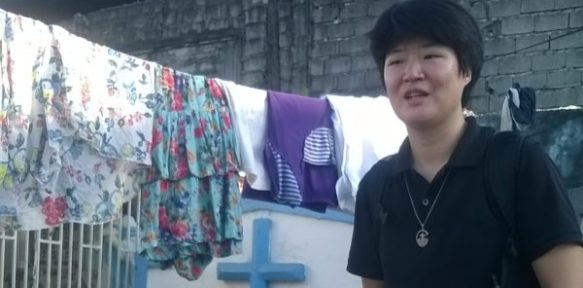
The people who live with the dead
Thousands of people in Manila live with the dead. Yes, you have read that correctly.
Living souls, homeless and penniless have no choice but to live amongst the grey tombs that house the deceased in one of the sprawling cemeteries in the bustling city.
During the run up to our World Missions Ireland trip to the Philippines and South Korea, where we were accompanied by journalist Charlie Bird, we heard about this situation in the cemetery and knew we had to go there. None of us could get our heads around the idea of people living in a graveyard.
The reality of finally seeing it was shocking. Almost 2,000 people are born, live and die amongst the graves.
They have nowhere else to go. They scratch out a living looking after the tombs and are particularly busy during November, the month of the Holy Souls. Just one public toilet caters for all these living souls, they have no running water; they have no electricity bar those who ‘jump’ it illegally putting themselves in mortal danger of electrocution. They are not on any tourist guide; they are invisible to most people, most of them don’t even have a birth certificate ; It is a shocking inditement of their society to think that they are only acceptable to the dead.
The cemetery is one of the biggest in Manila. Established in 1927 it began to make room for the living in 1975. People with nothing and nowhere to live began to seek out shelter amongst the tombs and little by little more and more people began to live there.
The city’s leaders have tried on several occasions to evict them but seem happy enough to turn a blind eye.
Turning a blind eye was not an option for the Columban Missionary Sisters who help them and are their prime lifeline. Srs Julie and Bella from Korea were put in contact with them though the local Jesuits and so began a process which is helping to give them some dignity and hope. Sr Julie says “When I first saw them they were like animals; eating and drinking from the ground, it was shocking and sad. We have done a lot of work with them; we have feeding programs, we have taught them about hygiene and personal health, we have taught them about respect for others and themselves but it is an uphill battle. Their lives are a constant daily struggle. I say to them what colour is your God and they say yellow, the colour of hope”.
With assistance from local Jesuits, the Sisters were able to provide one toilet to cater for all the people but this is patently not enough. Volunteers help out with the feeding program three times a week and Julie and Bella have a little centre , the Mosaic Centre, where the children can go and have some time to learn, to wash and to feel ‘normal’.
Julie says “There is no privacy whatsoever in the cemetery and the children are exposed to all sorts of things that they shouldn’t be. You can just imagine. Sadly they are very very vulnerable. Our little Mosaic Centre at least gives them some time to be children”.
We visited on a sweltering hot day and the residents were busying themselves with their tasks for the day. Drawing water from one of the two wells, lighting fires to cook a meagre breakfast, washing clothes, playing with their children, chatting amongst themselves.
Ordinary things in an extraordinary setting.
Makeshift clothes lines strung up across the tombs , cardboard or plastic piled together to try and provide a roof over the tombs shelter , small fires to try and boil some water ; it all made for an incredibly disturbing but strangely grounding scene. The people who live there were very happy to see us, meet and talk to us and happier still when we chatted to them and hugged their little children. It was hugely touching to speak to the teenagers and hear about some of the dreams they have … to have a job, to have a real house, to have a real bed to sleep in; most of the things we generally take for granted. It was almost more touching still to hear that they now can begin to have those dreams as a result of the care, dedication, dignity and respect shown to them by the two Columban Missionary Sisters . Not content naturally with just giving the people food, the sisters are feeding their souls and spirits, giving them confidence and the knowledge that they are worthwhile people deserving of kindness, value and hope.
For Srs. Julie and Bella it is vital that they keep positive. Julie says “our motto here is never give up and that is as much for us as for the people who live here. We say it to them every day, never ever give up. You have to go on, have hope and faith and belief in a better future for you and yours”.
Giving up is never an option for the thousands of missionaries throughout the world each doing his or her bit to make a difference.

